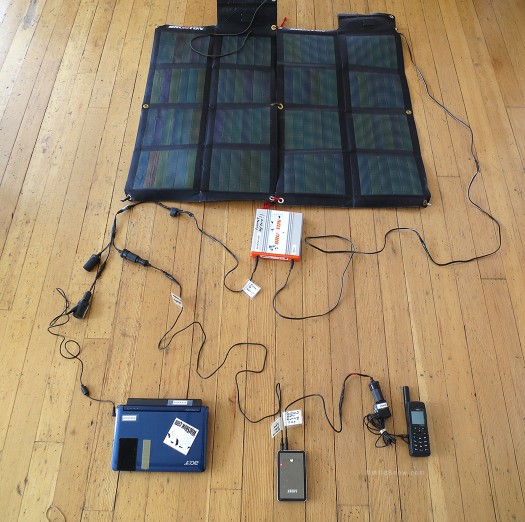Some of you may recall the lower budget satphone blogging system we used during our 2010 Denali ski expedition. I still use the Iridium 9555 satphone, but the other ingredients came back from Denali a bit ragged and I had most of the stuff just stored away or put into use in other applications (the solar panels come in handy for temporary use at Field HQ, for example). Louie says he’ll file dispatches from some glacier in Alaska at the end of the month, so I resurrected the system and sent it up to him. It took quite a bit of work and money to put it all back together. Hopefully it’ll be worth it!
The basic ingredients:
— Acer netbook, same one used on Denali, rebuilt, SSD hard drive
— Iridium 9555 satphone
— Brunton Solo battery acts as charge and voltage controller
— Anker battery (smaller) for spare, runs satphone and charges iPods, can be connected directly to panels or to main battery
— Miscellaneous connectors made in WildSnow modshop, standardized to either cigarette plugs or one size electrical jack
— Brunton fold-up solar 26 watt arrays, 2, jumpered together or can be operated separately
— UUplus optimized satphone email service
— Optional satphone external antenna (not pictured) improves performance in fringe areas or when phone needs to be used in RF blocking shelter
Basically the system works like this: you set up the solar system so it keeps everything charged up, then on the computer you write your blog copy and process your photos. Using the UUplus satphone data service, you upload everything as email to a ground person back in civilization who assembles the blog post and publishes it. It’s possible to go all the way to publication from the remote location, but doing so requires many more expensive satphone minutes and preferably more bandwidth. Thus, using a ground person is much more efficient and practical.
It takes quite a bit of care and expertise to successfully use the system. On Denali, I was surprised at how much time it took me, and how easily things could be broken or otherwise disabled. Problem is, you don’t have a desk and you don’t have a repair shop.
Setting up the solar is simple. Always use plenty of panel wattage, as there is nothing worse than having slightly less power than you really need. Hook up a fairly large battery pack to the panels, for storage and to act as charge/voltage regulator. Hook everything else to the battery, being careful of how much load you ultimately put on the system (be sure there are various fuses in the system, and check equipment and wires for overheating).
Extensively test everything at home, and bring as much redundancy as possible to the field. For example, our system doubles up on just about everything except the satphone (though on Denali we did have two satphones of the same model, which was good).
There are many ways to remote blog (with photos) these days, with more or less money, different gear and so forth. Our system still seems to be one of the most efficient in terms of weight and cost, though it’s still pricey and the weight does add up.
WildSnow.com publisher emeritus and founder Lou (Louis Dawson) has a 50+ years career in climbing, backcountry skiing and ski mountaineering. He was the first person in history to ski down all 54 Colorado 14,000-foot peaks, has authored numerous books about about backcountry skiing, and has skied from the summit of Denali in Alaska, North America’s highest mountain.

